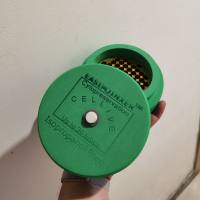Procedure to purify protein from cells
互联网
This procedure is used to break cells that contain a protein to be purified.This procedure is valid only for the use on Appling's lab sonicatior.
PREPARATION
1.Place your sample in a 15ml elongated plastic tube such that the sample-tube wall interface area is maximized.
2.Fill a small container with ice and salt (NaCl)and then add a small amount of water (the salt lowers the freezing temp.).
3.Place the tube with the sample in the ice container making sure that the ice bath completly covers the walls of the tube.
SONICATION
1.Turn on the sonicator and calibrate by placing the 20/40 switch in the 20 possition and the control power switch in the 60 postion.Start the apparatus by pressing the foot pedal and move the calibration knob such that the output signal is at a minimun.
2.Move the power switch top the 100 position and repeat above calibration procedure.
3.Clean the probe with ethanol,let dry,and place it inside the tube.Make sure that the cold tube is inside the ice container.Move the 20/40 switch to the 40 position and the power switch to 70.Wear your protective headfones and start the sonication.Leave the sonicator on for 30 seconds and then release the foot pedal.
4.Wait about one or two minutes until the tube cools down again and gently shake the tube.Place it on ice and repeat the experiment.
5.Move the power switch to 90 and repeat the experiment.The sequence of sonication is 2X at 70 for 30 seconds and 1X at 90 for 30 seconds waiting 1-2 minutes on the ice bath in between.
Note:
Some proteins resist sonication more than others so different times may be needed.The initial cell sample is viscous and as the sonication process the viscosity of the sample decreases due to macromolecular shearing.Another way to monitor the amount of sonication needed to break open the bacteria is to monitor the release of DNA and RNA by measuring the absorbance at 260 nm of your sample after every sonication step.The A260 will increase until it reaches a plateau--this means all the bacteria are lysed and no more nucleic acids can be liberated.Always remember to cool down your sample in between and after soniication to prevent heat denaturing your protiens









